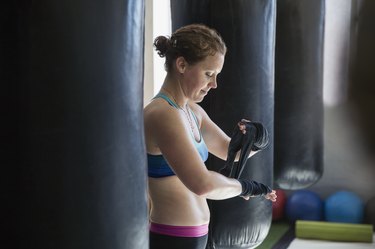
Hitting punching bags is an essential part of training when you are getting ready to box or engage in a mixed martial arts bout. It's not usual practice to throw on boxing gloves without wraps for at least part of your training. But every time you get in the ring to box or go to the gym to train, you have to wrap your hands to protect them, and if you're hitting hard, it's best to wrap your hands during practice sessions, too.
Tip
Although you don't necessarily need to wrap your hands for every aspect of your boxing or MMA training, hand wraps are a vital part of your protective equipment. Putting them on before you hit a punching bag will help protect your hands and wrists from an injury that could at best temporarily derail your training, and at worst leave you permanently out of the ring.
Video of the Day
Security While Training
The hands are delicate, and the sport of boxing can easily injure them whether training on the heavy bag or boxing against an opponent. Hand wraps protect the small bones in the hand from breaking, keep the skin on the knuckles from tearing and help prevent you from spraining your wrists when delivering a solid punch.
Video of the Day
The latter problem frequently impacts inexperienced fighters who are hitting the heavy bag for the first time. Many fighters who have not hit a bag that can weigh between 75 and 100 pounds will swing their arms and hit the bag with their fists. Experienced fighters know they must use their legs, hips, core muscles and upper body when throwing hard punches — but the harder you hit, the more damage you risk doing if you hit a punching bag without gloves and hand wraps.
Boxing Hand Wrap Technique
There are a variety of wraps to choose from, but for the best results don't buy wraps that are less than two inches in width. The length of the wrap will vary from 120 inches for someone with a small hand to 170 inches for boxers with bigger hands.
There are several ways of applying hand wraps, and it's almost impossible to learn via text alone; so a good teaching video is your best friend. One method involves starting with the loop at the end of the wrap around your thumb, then going around the wrist several times, and finally winding the wrap alternately between your knuckles and back to your wrist to offer more support to the bones of your hand.
Avoid Hand Injuries
Boxers cannot be cavalier about putting on the wraps or go in for a quick session on the bag and think that they can get away without wrapping them. Fighters who suffer broken fingers, broken hands or sprained wrists must take time off to let the injuries heal. This impacts a fighter's ability to learn and improve.
Pain While Punching
Fighters depend on the health of their hands to engage in their sport. While fighting — boxing and mixed martial arts — requires a huge amount of toughness and desire, pain while punching means that you must stop and get it checked out. You may have a small broken bone and if that injury does not heal properly, you may never be able to throw a punch with full power again. Wrap your hands properly before every training and boxing session and make sure you check out any hand injury.
Consider Training Goals
If you are working light aerobic boxing on the bag, then hand wraps really may not be necessary so long as you have on gloves of some kind. Some people prefer to train in MMA style gloves that don't always accommodate hand wraps underneath. The majority of hardcore boxers and fighters will always wrap their hands, but if the intent is far less "serious" in the training and the impact minimal, it's possible to just use gloves without wraps.